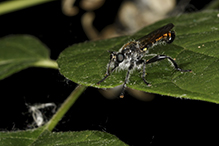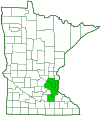bee-mimic robber fly
(Laphria index)
Conservation • Description • Habitat • Biology • Distribution • Taxonomy
Conservation Status |
|
|||||||
| IUCN Red List | not listed |
|||||||
| NatureServe | not listed |
|||||||
| Minnesota | not listed |
|||||||
Description |
||
Laphria index is a small to medium-sized bee-mimic robber fly. It occurs in the United States from the northeast to the Midwest, south to Virginia and Missouri, and in adjacent Canadian provinces. It is uncommon in Minnesota. Adults are dark, slender, and ½″ to 11 ⁄16″ (13 to 18 mm) long. There are two large compound eyes and three small simple eyes (ocelli). The compound eyes extend above the level of the top of the head (vertex), making the head appear hollowed out between the eyes when viewed from the front. The ocelli are arranged in a triangle on a prominent rounded projection (tubercle) in the middle of the head between the compound eyes. There is a dense mustache of long, stiff, black bristles (mystax) on the face immediately above the mouth. The antennae have 3 segments. The third segment is elongated. The thorax is black with a narrow triangle of pale to reddish-gold hairs on the upper (dorsal) surface. The triangle is widest at the rear, about as wide as the triangular plate between the thorax and abdomen (scutellum). It narrows rapidly to at least the middle of the thorax, and fades at the tip. The hairs are iridescent and the color varies with the angle of the light. The rest of the thorax is covered with longer whitish hairs and shorter black hairs. The scutellum is covered with paler hairs and has a white bristles on the margin. The small, knob-like structures on each side of the thorax (halteres) are yellow. The abdomen is long, slender, and black, and has six segments. The first two segments are black with white hairs on the side. Segments 3 through 6 are densely covered with orangish-gold hairs. On the male, at the rear margin of segment six, there are two black, well-defined projections. The genital bulb at the tip of the abdomen is black and very large. The wings are clear. They are dark smoky brown at the tip, becoming paler at the base. The first and second branches of the radial sector vein (R1 and R2+3) join before the end of R1 creating a closed cell that does not reach the margin. The legs are stout and black. They are covered with long gray and black hairs. The last part of the leg (tarsus), corresponding to the foot, has five segments. The last segment has 2 pads. |
||
Size |
||
Total length: ½″ to 11 ⁄16″ |
||
Similar Species |
||
Bee-mimic robber fly (Laphria ithypyga) is very similar in appearance. On the male, the genital bulb is “substantially smaller”. At the tip of the abdomen there is just a single small projection. Neither of these characteristics is visible on most photos. The female “appears to be more robust”, and the golden triangle on her thorax “more conspicuous” (BugGuide.net). Based on the recorded sightings, this species is much less common. It has not been recorded in Minnesota, though CCESR does have it on their state insect checklist as Choerades ithypygus. |
||
Habitat |
||
Woodland edges and openings |
||
Biology |
||
Season |
||
June through mid-August |
||
Behavior |
||
|
||
Life Cycle |
||
|
||
Larva Food |
||
|
||
Adult Food |
||
|
||
Distribution |
||||
|
Sources |
|||
| 10/4/2022 | ||||
Occurrence |
||||
|
||||
Taxonomy |
|||
Order |
Diptera (flies) | ||
Suborder |
Brachycera | ||
Infraorder |
Muscomorpha (=Cyclorrhapha) | ||
Superfamily |
Asiloidea | ||
Family |
Asilidae (robber flies) | ||
Subfamily |
Laphriinae | ||
Tribe |
Laphriini | ||
Genus |
Laphria (bee-mimic robber flies) | ||
| no taxa | bee-mimic robber flies (Laphria index complex) | ||
Synonyms |
|||
|
|||
Common Names |
|||
Few of the North American Laphria species have a common name. One common name for the genus is bee-mimic robber fly, and it is applied here for convenience. |
|||
Glossary
Halteres
In flies: a pair of knob-like structures on the thorax representing hind wings that are used for balance.
Mystax
On flies, especially in the family Asilidae, a patch of bristles or hairs (mustache) immediately above the mouth.
Ocellus
Simple eye; an eye with a single lens. Plural: ocelli.
Scutellum
The exoskeletal plate covering the rearward (posterior) part of the middle segment of the thorax in some insects. In Coleoptera, Hemiptera, and Homoptera, the dorsal, often triangular plate behind the pronotum and between the bases of the front wings. In Diptera, the exoskeletal plate between the abdomen and the thorax.
Tarsus
On insects, the last two to five subdivisions of the leg, attached to the tibia; the foot. On spiders, the last segment of the leg. Plural: tarsi.
Visitor Photos |
|||||
Share your photo of this insect. |
|||||
| This button not working for you? Simply email us at info@MinnesotaSeasons.com. Attach one or more photos and, if you like, a caption. |
|||||
Alfredo Colon |
|||||
An Awesome Robberfly |
|||||
 |
|||||
MinnesotaSeasons.com Photos |
|||||
|
|||||

Slideshows |
||

Visitor Videos |
|||
Share your video of this insect. |
|||
| This button not working for you? Simply email us at info@MinnesotaSeasons.com. Attach a video, a YouTube link, or a cloud storage link. |
|||
Other Videos |
|||
| Robber Fly (Asilidae: Laphria index) Male, Close-up Carl Barrentine |
|||
About
Published on May 29, 2012 Photographed at the Turtle River State Park, North Dakota (29 May 2012). Thank you to Herschel Raney (@Bugguide.net) for confirming the identity and for suggesting the sex of this specimen! |
|||
| Laphria index ORANGE ROBBER FLY Rob Curtis |
|||
About
Published on Nov 19, 2017 Laphria index ORANGE ROBBER FLY |
|||
| Robber Fly (Asilidae: Laphria index/ithypyga complex) Female Feeding Carl Barrentine |
|||
About
Published on Jun 24, 2012 Photographed at the Turtle River State Park, North Dakota (24 June 2012). Thank you to Tristan McKnight (@Bugguide.net) for determining the sex and probable identity of this specimen! |
|||

Last Updated:


